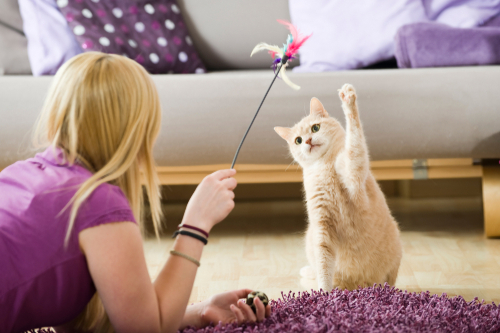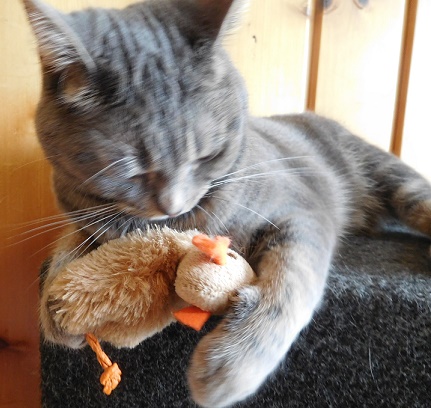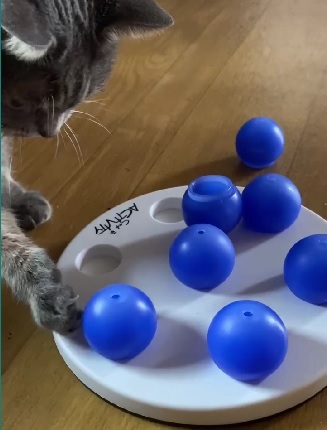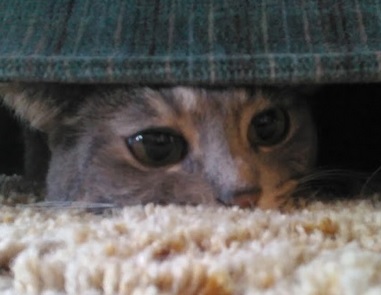
Sometimes we think that giving our cats healthy food, throwing some toys on the floor, and buying a fancy pet bed we are making our cats happy. The truth is these elements are important, but one of the most important things for cats is playing on a daily basis. Healthy food is essential, but physical and mental stimulation is equally crucial.
Why Is Playing With Your Cat Important?
Because cats are natural hunters. In the wild, they’re constantly on the move—chasing prey, exploring new environments, and stalking their next meal. Even though they’re domesticated, their hunting instincts haven’t disappeared. They still have a deep-rooted need to stay active, chase, and pounce.
A study published in Frontiers in Veterinary Science found that when play is withheld from cats, observable behavioral changes occur that may indicate a decrease in their welfare or well-being. Conducted with 1,591 cat owners, the research revealed that increased attention-seeking behaviors, such as vocalizations and destructive actions, may suggest frustration, a negative emotional state that can impact a cat’s overall health and happiness.
So, how does playing with your cat benefit them? Here are six key reasons why it’s essential to make playtime part of your daily routine:
6 Reasons Why You Should Play With Your Cat Every Day
Playing with your cat is just as important as walking your dog. Here are six key reasons why you need to engage your feline friend in active games every day:
#1 Prevents Anxiety, Stress & Destructive Behavior
When cats don’t get enough stimulation, they accumulate excess energy, which often results in anxiety and stress. A study published in Journal of Applied Animal Welfare Science explored the effects of environmental enrichment on indoor cats, noting that the inability to engage in natural behaviors, such as hunting and exploring, can lead to stress-related problems (Sage Publications, 2015). Signs of a stressed cat include:
✅ Overgrooming (licking excessively, leading to bald spots)
✅ Aggression (toward people or other pets)
✅ Knocking things over (cups, candles, decorations)
✅ Hiding all day and avoiding social interaction
✅ Not using the litter box properly
Play is an easy and effective way to relieve this stress by burning energy and keeping your cat’s mind engaged. If your cat shows signs of anxiety or boredom, increase playtime and observe how their behavior improves.

#2 Helps Maintain a Healthy Weight
Obesity in cats is a growing problem, leading to diabetes, joint pain, and shorter lifespans. Playing is one of the best ways to keep your cat in shape naturally. Even if your cat loves food, you can help them stay at a healthy weight just by making playtime a daily habit.
💡 Pro Tip: Use interactive treat toys like a treat-dispensing ball to encourage movement while rewarding them with small treats. It combines mental and physical exercise in one!
#3 Provides Essential Mental Stimulation
Not only do humans need mental stimulation, but cats do too. In the wild, they strategize to catch prey—whether it’s stalking a bird, pouncing on a mouse, or retrieving a bug from under a rock. This constant activity keeps their minds sharp. However, indoor cats don’t have the same challenges, and sometimes they seem uninterested in play.
💖 Real-life example: I’ve noticed this with my own cat—sometimes, after she’s been resting for a while, I’ll throw toys, roll a ball, or dangle a teaser wand, and she just sits there watching, completely unbothered. In the past, I would give up, assuming she wasn’t in the mood. But recently, I’ve learned that persistence pays off! If I keep trying, she suddenly seems to ‘wake up’ from her rest and starts engaging. It’s like her hunting instincts need a little time to activate, but once they do, she’s fully invested in the game.
This experience shows how important it is to keep your cat mentally engaged and not assume they don’t want to play just because they don’t react immediately. Switching up toys, mimicking prey movements, or just being patient can make all the difference.

#4 Improves Coordination & Hunting Skills
Regular play improves your cat’s agility, strength, and reflexes. When cats leap, pounce, and swat at toys, they enhance their balance and precision, reducing the risk of failed jumps that could cause injuries.
🐾 Try this: Encourage your cat to jump over obstacles or reach for a toy mid-air. These small challenges help develop muscle strength and sharpen their natural hunting skills.
My Cat Sophie Playing with Her Fav Toy
#5 Strengthens Your Bond With Your Cat
Every time you engage in play, you build trust and deepen your bond. When you interact with your cat through play, you become more than just a food provider—you become their playmate and companion. This is especially important for shy or newly adopted cats. Regular play makes them feel safe, comfortable, and more affectionate toward you. Over time, they’ll follow you around and seek your attention more often.
A research on cat play and bonding highlights play as a valuable tool for providing environmental enrichment and strengthening the cat-human bond. Engaging in regular play sessions not only supports a cat’s physical and mental well-being but also fosters a deeper connection between cats and their owners.
💖 Real-life example: My cat, Sophie, used to be distant. But after consistent play sessions, she now follows me everywhere and even allows me to clean her ears and eyes without resistance. That’s the power of trust through play!
#6 Reduces Nighttime Zoomies & Disruptions
Does your cat run wild at 2 AM? That’s because they still have unused energy from the day! A longer play session before bed can help burn off that extra energy, making your cat calmer at night. This simple trick can prevent midnight zoomies and help you sleep better too!

FAQs: Common Questions About Playing With Cats
How long should I play with my cat each day?
A minimum of 15 minutes (straight) per day is recommended, but more is always better. Younger and more active cats may need 30+ minutes to stay satisfied.
What are the best toys for interactive play?
🐾 Teaser wands (simulate prey movements)
🐾 Laser pointers (great for chasing, but always end with a real toy so your cat “catches” something)
🐾 Puzzle feeders (combine play and reward)
🐾 Cat tunnels & climbing structures (encourage movement)
What if my cat doesn’t seem interested in playing?
Some cats take time to engage in play. If your cat seems uninterested at first, don’t give up too quickly! Try:
✅ Using different toys – Some cats prefer fast movement, while others enjoy slower, “stalking” games.
✅ Combining toys – My cat Sophie loves to hide and pounce from tunnels or other hiding spots. Her three-way tunnel makes it even more fun, especially with an automatic rotating toy placed at the end of one of the tunnels—it’s been a game-changer!
✅ Playing in short bursts – Cats often have quick energy spikes rather than long, continuous play sessions, so shorter but frequent sessions can be more effective.
✅ Scheduling play before meals – This mimics their natural “hunt before eating” instinct and can boost their motivation to play.
✅ Being persistent – If your cat isn’t engaging right away, keep trying! Sometimes, after a little patience, they suddenly “wake up” and get into play mode. Even if they just watch at first, continuing to move the toy in different ways can trigger their hunting instincts, leading to full engagement.
✅ DIY Toys – If you’ve tried every toy and your cat still isn’t interested, it might be time to get creative! Making your own toys can be a great way to spark their curiosity. In my article “When Cats Don’t Play Easily”, I share tips and ideas on how to encourage play, including DIY toys that have worked for my cat.
Final Thoughts: Make Playtime a Daily Habit!
Playing with your cat isn’t just fun—it’s essential for their physical, mental, and emotional well-being. By making play a daily routine, you’ll have a happier, healthier cat who trusts and loves you even more.
Try it today! What’s your cat’s favorite game? Let me know in the comments!
Some content contains affiliate links or samples for reviews; I may receive compensation. Learn more
Leave a Reply